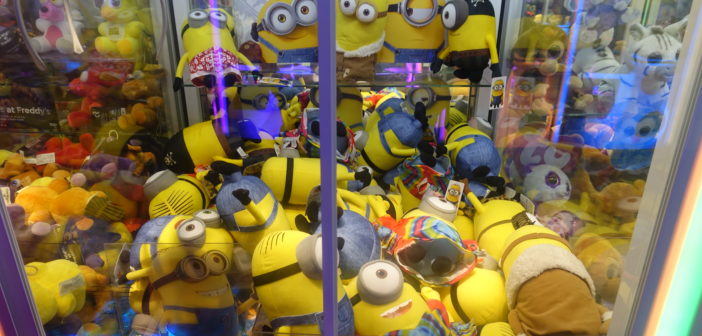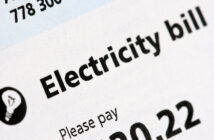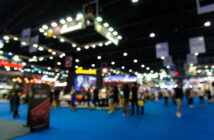What’s Hot…And What’s Not –– Part Eight
Making More Money With Cranes While Having Happy Players & Locations

Frank Seninsky
by Frank Seninsky, President/CEO Amusement Entertainment Management (AEM) & Alpha-Omega Amusements & Sales
I recently received an email from an veteran industry couple that runs a 30-location crane route, a business that is declining and doesn’t make much money. They strongly feel they do a much better job servicing their accounts than their competitors, but see a number of factors as reasons why they’re struggling: increasing cost of merchandise; special arrangements other operators have with the better locations (exclusive contracts, loans, etc.); and locations closing.
Getting deeper into their situation, it was easy to see why they were in trouble, even after being in the business over 15 years. They were running their business without really understanding the basic ground rules for operating cranes. Maybe others out there could use a refresher (or might be getting this information for the first time).
What is Hit Frequency and Why Is It Important?
Definition: Hit Frequency is a ratio of how many times you succeed (win) versus how many times you try (play).
With cranes, Hit Frequency is simply the number of times a player wins a prize versus the number of total plays.
Hit Frequency = Wins/Plays
That’s all it is. The amount or number of what you win doesn’t matter. By the way, you can also relate this ratio to sports and various experiences in life. For each, there’s a magic number or ratio for how many times you’re willing to try something and fail before you become so frustrated that you give up trying.
The example I give at Foundations University comes from my own life experience. I remember wanting to ask a girl to the dance in seventh grade. The first girl I asked, said “no,” as did the second. Actually, the first 11 turned me down and I was about to quit in frustration. But when I went up to the 12th girl, she said yes! That basically set me on a life path where that was my Hit Frequency limit: 1 win out of 12 tries (1:12). Scientifically, studies have been conducted that show that 1:12 is also the maximum limit for most other people worldwide (until current times…some people expect to succeed much faster today while others are content to “fail” many more times to win a high-value prize).
When you’re setting up a crane, you have to be within that Hit Frequency of 1:12…or better.*
With a regular skill crane, the player needs to win 1 time out of every 10, 11 or 12 plays. It’s rare that you’ll make money with any lower Hit Frequency. Players simply don’t like to fail more than 12 times in a row on average.
Here are the three steps:
Step 1: Pick your starting benchmark Hit Frequency. I recommend 1:12.
Back in the early 1960s (that is my living industry reference point) cranes were priced at 25 cents per play, increasing over time to 50 cents/play and now at a $1/play or higher.
Step 2: You have to choose what you’re going to charge per play based on what people can afford in that location, as well as what the costs per play are of the other games in that location.
Let’s say you charge $1 per play and you decide you want a Hit Frequency of 1:12. Next, you must determine how much you want your cranes to pay out. This is known as Win Percentage or Cost of Sales. I recommend starting with 25 percent as a benchmark, but it could be as low as 20 or as high as 30 percent). Remember, “Winners make players!”
What exactly is the Cost of Sales for a crane?
Example: At $1 per play and a Hit Frequency of 1:12 and a desired Win Percentage of 25 percent, using fourth grade math you can find what your prize cost must be:
25% = Prize Cost/$12
Prize Cost = 25% x $12
Prize Cost = 0.25 x $12 = $3
Step 3: Search the market for the most desired prize you can purchase for $3 (including shipping and sales tax – so the line item cost is approximately $2.75) that your crane claw can pick up (prize size, weight and shape are all critical).
One way to pick what prizes players want to win is by simply watching children’s TV shows every Saturday morning, but, of course, you can get that information from one or more of our industry’s terrific prize suppliers’ catalogs (for example, Sureshot Redemption, Rhode Island Novelty, HMS Monaco and so on).
Additionally, there are two sections in my Redemption & FEC Report that detail prizes: “Top 15 Merchandise Machines and What Prizes are in Each Bay” and “Top Redemption Prizes” posts from the past few issues, covering prizes from 1 cent to $20 wholesale (see links in the box below). (By the way, all of the current and past Redemption & FEC Reports are available at frank-thecrank.com site; subscribing is free.)
There’s another very important factor involved in prize selection: You have to make sure that the crane you have has a claw size that can pick up the prize item you’re choosing! The prize can’t be too big, too small or too heavy for your claw or have an odd shape that it can’t grasp. Experienced operators actually buy different claw sizes for the prizes they’re running. (Did you just have an “Aha!” moment?)
Another Approach: You can start with a special prize you believe is a great choice and work the same formula with the three steps above in a different order. For example: Your chosen prize costs you $2 and you still want your Win Percentage to be 25 percent and Hit Frequency to be 1:12. That is what you start with. Now you can do a few simple calculations to see what your possibilities are for price per play and Hit Frequency.
Let’s go through the math:
Try a Price/Play of $1 • [0.25 = $2.00/Hit Frequency] • Hit Frequency is 1:8 • Pretty good!
Try a Price/Play of 50 cents • [0.25 = $2.00/Hit Frequency] • Hit Frequency is 1:16 • Way too high!
Try a Price/Play of 75 cents • [0.25 = $2.00/Hit Frequency] Hit Frequency is 1:10.67 • Pretty good!
You can also fool around with the Win Percentage if you want to lock in on a specific price per play.
The problem that many crane operators encounter is that they try to do the math in their heads but don’t take Hit Frequency into account. They know what they want their Cost of Sales (Win Percentage) to be and are fixated on their price per play. Then, they see a prize they like that runs around the $3 cost, and prize costs keep going up. They don’t realize that every time they make the crane harder to play, they are increasing the Hit Frequency ratio.
And Now for the Rest of the Story of Our Veteran Crane Operating Couple
Running through the numbers shows the problem our veteran crane operator couple faces. They are stuck on believing that all of their cranes must be set on 50-cent play. Heck, they operate on quarters and don’t even get to take advantage of package discounts.
When I actually walked them through the math, it showed that they were unknowingly setting their cranes to have a Hit Frequency of 1:18 (exceeding our golden standard of 1:12). They were only making money in those high-volume locations where the players were transient and most only played a few plays, won nothing, and walked out the door.
However, in their locations where more of the players frequented the location, most of the cranes were grossing less than $50 per week. In fact, over dozens of locations –– even with one crane grossing $400 per week –– the total route average is less than $70 per week per crane.
With a Cost of Sales of 25 percent (0.25 x $70 = $17.50), and assuming the operator gets 50 percent of the net gross of $52.50, they will only earn a gross commission of $26.25 per crane per week.
Or, if the operator gets 70 percent of gross crane revenues (the operator pays for all prizes) and gives the location 30 percent, you’re looking at 70% x $70 = $49 less $17.50 prize cost for a total of $31.50 per crane per week.
There’s not much difference between the two scenarios.Deducting all operating expenses (gas, wear and tear on their trucks, driving/ repair/ordering/prize bagging, licenses, parts, insurance, taxes…) and the couple was working for less than minimum wage!
And What About You?
Are you paying too much attention to the myths (“fake crane news”)?
You hear directly from another crane operator, read or otherwise receive third- or fourth-hand information that a certain prize is the “hottest” thing since sliced bread, resulting in cranes grossing $250 per week. You find out where you can buy that item. Unfortunately, you don’t know if the information you received relates to the actual item you’re buying, having the same size, price, weight, shape, price/play, Win Percentage and Hit Frequency. But you jump on it anyway, buying 144 units (gross) of this “hot” item at a unit cost of $4. All of your cranes are set at $1 per play. You don’t really know what your Hit Frequency is, but with the last prize you had in your cranes, the Win Percentage averaged 20 percent.
At a Cost of Sales of $4 and Hit Frequency still at 1:12, your Win Percentage = $4/$12 = 33%. (No wonder your operator friends are seeing a revenue increase! Perhaps they don’t even know what their Win Percentage is. After all, that wasn’t part of the information you picked up on.) Since 33 percent is a pretty big increase over 25 percent, you loosen up the claw strength and next week the revenues drop like a rock because the players no longer have a reasonable chance of winning.
Remember, what we’re trying to do in the amusement industry is be fair to our customers because we want them to come back and keep playing. It’s supposed to be fun! When people lose over and over again, they tell everyone how you can’t win at cranes, perpetuating a negative public perception that’s a real problem for our industry.
Going back to the couple who wrote to me, they run their cranes at 50-cent play and recently started using $3 prizes. To maintain a 25 percent Cost of Sales, they have to take in $12 for each prize won. At 50-cent play, their Hit Frequency now calculates to 1:24. Is it any wonder their crane revenues have gone down?
At the 1:24 Hit Frequency (and with all the other criteria in place), players might try four or five times without winning before they leave. Clearly, they aren’t playing 20 more times…nor do they have a bunch of people standing around, watching and waiting for their turn to play. I can’t say this enough: When people lose over and over again, they tell everyone how “you can’t win at cranes.” That’s a problem, not only for this couple and their operation, but for the industry at large!
The Crank’s Winning Crane Formula
I came up with this method many years ago to make sure our cranes are set up properly, and each of our game technicians is still trained in this same procedure:
1. Start with a prize you think will attract players, works with your crane claw and is priced right to fit into your Win Percentage and Hit Frequency ratio.
2. Fill the crane to its maximum capacity level, exactly how you or your route personnel would when the crane is on location.
3. Play the crane yourself at least 100 times to see what your average Hit Frequency win rate is. If you win way too many prizes out of 100 tries, alter the several tension and claw/collar adjustments to have the prize be a little bit more difficult to win. If you don’t win enough, adjust the settings in the other direction, making the prizes a bit easier to win. (In a future article, we’ll go through the adjustments found on a crane; many are mechanical.)
4. After making the adjustments, play another 100 games. (Yes, it takes effort to get this right.) Repeat this process until you get to that 1 out of 12 average (that is an average of 8 wins out of 100 tries).
5. Put the crane out on location and check the collection at the end of the week to confirm your math. For example, if the Win Percentage is only 15 percent instead of 25, you have to tweak it. The idea is to ensure the players win enough to come back, but still give you a chance to make a living.
There is a lot more to running a fair and profitable crane operation, but this is a good place to stop for now. In Part 9, I will discuss additional ways to make more money with cranes such as the “1/3rd Rule,” how to load prizes into a crane, fine tuning cranes and a whole lot more!
Meanwhile, please email with your comments and tips: [email protected]. Readers are also welcome to call my cell or text: 732-616-5345.
As always, keep cranking!
Redemption & FEC Report Links
Here are the links (shortened to make it easier to type into your browser):
• Top 100 Redemption Prizes Redeemed 5 Points to 100 Points July 2018: tinyurl.com/ybmpvv36
• Top Redemption Prizes Redeemed 100 Points (75 cents) To 1500 Points ($10) Summer 2018: tinyurl.com/yboc4eww
• Top Prize Items Redeemed 1515 points ($10) to 3000 points ($20) – 143 Prize Items: tinyurl.com/ybbaacsf
• Top 18 Crane Merchandiser Games & Prizes in Each Bay December 2018: tinyurl.com/yb77ua4s
Frank Seninsky is president of the Alpha-Omega Group of companies, which includes a consulting agency (Amusement Entertainment Management), two nationwide revenue-sharing equipment suppliers (Alpha-Omega Amusements and Alpha-BET Entertainment), and Alpha-Omega Sales, a full-line game and related equipment distributor. During his 47 years in the leisure entertainment industry, Seninsky has presented nearly 400 seminars and continues to regularly write columns in numerous trade publications. He served as president of the AMOA (and was on the board for 22 years), and was president of IALEI (founding member and on the board for 11 years). Frank is the sole owner of Foundations Entertainment University, now in its 16th year. He is also considered a leading industry expert in the design, layout, and operations of coin-/debit card-operated arcades and FEC attractions, and is often called upon as an expert witness in cases involving the amusement industry. Frank edits The Redemption & FEC Report e-newsletter (35,000+ readers worldwide) and also writes a blog at www. frank-thecrank.com. Frank can be reached by phone at 732- 616-5345 or by email at [email protected] (website: www.AEMLLC.com).





1 Comment
Pingback: Making More Money With Cranes While Having Happy Players & Locations - Frank 'the Crank' Seninsky Blog